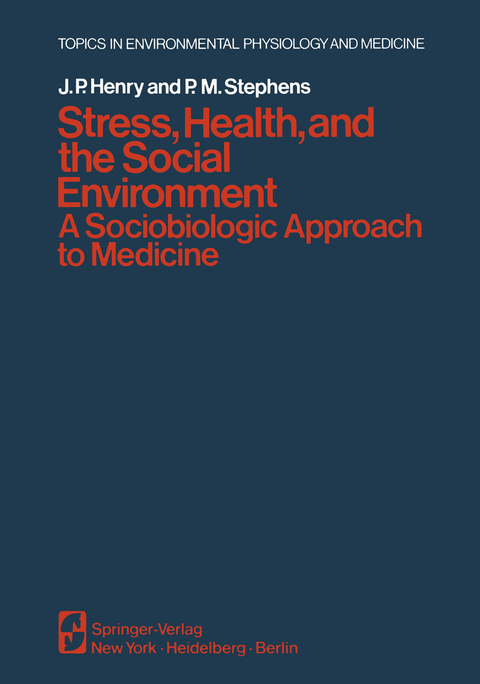
Stress, Health, and the Social Environment
Springer-Verlag New York Inc.
978-1-4612-6365-4 (ISBN)
1 A historical introduction and theoretical concept.- Donnison’s Civilization and Disease.- Halliday’s Psychosocial Medicine: A Study of the Sick Society.- Emotion as a driving force in evolutionary biology.- Cannon and stress; Selye and distress.- Wolff’s Stress and Disease.- Hinkle’s studies of sociocultural changes and health.- Holmes-Rahe life change and illness susceptibility scale.- Theoretical mechanisms of psychosomatic disease.- Social environment as initiator of a chain of events.- Our format: from stimulus to pathology.- Summary.- 2 Basic patterns of social interaction.- The basic patterns.- Territory in relation to dominance and subordination.- Dominance and subordination in monkeys.- Conflict behavior in rhesus monkeys.- Dominance and subordination in man.- Depression and loss of status.- Male and female patterns of behavior.- Male-female differentiation in the kibbutz.- Attachment behavior in female mice.- Maternal attachment in primates.- Mother-infant attachment in man.- Generalization of attachment during maturation.- The wish to be held and the need for attachment.- Human sexuality as a behavioral reward system.- Behavior of the aged food gatherer.- Summary.- 3 Inherited behavioral patterns as social assets.- Normal behavior patterns of mice.- A disordered rodent society.- Normal primate behavior patterns.- A disordered primate society.- Normal behavior patterns of hunter-gatherers.- A disordered primitive human society.- Summary.- 4 The critical role of early experience and the programming of behavior.- The critical role of early experience.- Socialization in mice and early experience.- Socialization in subhuman primates and early experience.- Programming of behavior in man and early experience.- Innate facial expressions and body gestures inman.- Summary.- 5 Monitoring behavioral disturbances in experimental social systems.- Concepts and reasons for monitoring.- Basic types of behavioral monitoring.- Techniques for producing behavioral disturbances.- Primate experiments.- Rodent experiments.- Comparison of results for mice and primates.- Summary.- 6 The role of the neocortex and the limbic system in social interaction.- Introduction: man’s four brain systems.- The evolutionary origin of lateralization.- Functional differences between the two hemispheres.- Lateralization of emotion.- Cerebral lateralization and sexual differentiation in man.- The limbic system: affect and programmed behavior.- The hippocampus and territory: the amygdala and reward.- Patterns of thinking and susceptibility to psychosomatic disease.- Experimental sleep disturbance and failure of communication between the limbic system and the neocortex.- Summary.- 7 Neuroendocrine responses to social interaction.- The frontal lobes and amygdalar and hippocampal function.- The amygdala and Cannon’s sympathetic adrenal-medullary defense pattern.- Peripheral effects of the sympathetic adrenal-medullary response.- The hippocampus and adrenocortical secretion.- Depression and the pituitary-adrenocortical mode.- Endocrine characteristics of dominant and subordinate status in animals.- Endocrine characteristics of Type A and Type B personalities.- The inverse relation between the gonadotropic hormones and the defense and alarm reactions.- Summary.- 8 Functional and structural changes in response to psychosocial stimulation.- Distinction between Cannon and Selyean stress.- Changes primarily related to the sympathetic adrenal-medullary response.- Changes primarily related to the pituitary adrenal-cortical response.- Adrenal-cortical hormones andmyocardial damage.- Psychosocial effects and immune response mechanisms.- Neuroendocrine mechanisms and mammary tumor formation.- Summary.- 9 Production of disease in animals by psychosocial stimulation.- Effects of acute psychosocial stimulation.- Effects of chronic psychosocial stimulation.- Lack of informational feedback and pathophysiology.- Chronic psychosocial stimulation and blood pressure elevation in mice.- Psychosocial factors and arteriosclerosis in CBA mice.- Rate of development of pathologic changes.- Psychosocial stimulation and renal damage.- Acceleration of pathologic changes by caffeinated beverages.- Summary.- 10 Pathophysiologic consequences of human social disturbance.- Tough and easy cultures.- Cardiovascular disease in Roseto.- Friedman and Rosenman’s Type A versus Type B behavior pattern.- Monastic life and coronary heart disease.- Contrasts between traditional Japanese and American cultures.- Coronary heart disease in acculturated Japanese-Americans.- Myocardial infarction in former medical students.- Bereavement and myocardial infarction.- Blood pressure and cultural change.- Psychosocial factors, salt, and hypertension.- Cancer of the lung and psychosocial parameters.- Psychologic attributes of breast cancer.- Summary.- 11 The prevention and treatment of detrimental effects in the psychosocial environment.- Natural defenses against stressful events.- Individual coping behavior: conservation-withdrawal and group-oriented responses.- Psychosocial assets and the group.- Social support as a moderator of life stresses.- Combat studies of group-coping mechanisms.- Small groups and the control of psychosocial stimulation.- Relaxation response and biofeedback in the control of hypertension.- Physiologic mechanisms and the relaxation response.- Therelaxation response in a religious context.- The cultural canon as a social asset.- Loss of the cultural canon and social breakdown.- The compensatory role of religion in a culture.- An effective cultural canon protects against disease.- Conclusions.- Glossary of sociobiologic terms.- Author index.
| Reihe/Serie | Topics in Environmental Physiology and Medicine |
|---|---|
| Zusatzinfo | XII, 282 p. |
| Verlagsort | New York, NY |
| Sprache | englisch |
| Maße | 178 x 254 mm |
| Themenwelt | Sachbuch/Ratgeber ► Natur / Technik ► Garten |
| Geisteswissenschaften ► Psychologie ► Sozialpsychologie | |
| Medizin / Pharmazie ► Medizinische Fachgebiete ► Arbeits- / Sozial- / Umweltmedizin | |
| Naturwissenschaften ► Biologie ► Ökologie / Naturschutz | |
| Schlagworte | Health • Sozialmedizin • Sozialverhalten • Stress |
| ISBN-10 | 1-4612-6365-4 / 1461263654 |
| ISBN-13 | 978-1-4612-6365-4 / 9781461263654 |
| Zustand | Neuware |
| Haben Sie eine Frage zum Produkt? |
aus dem Bereich


